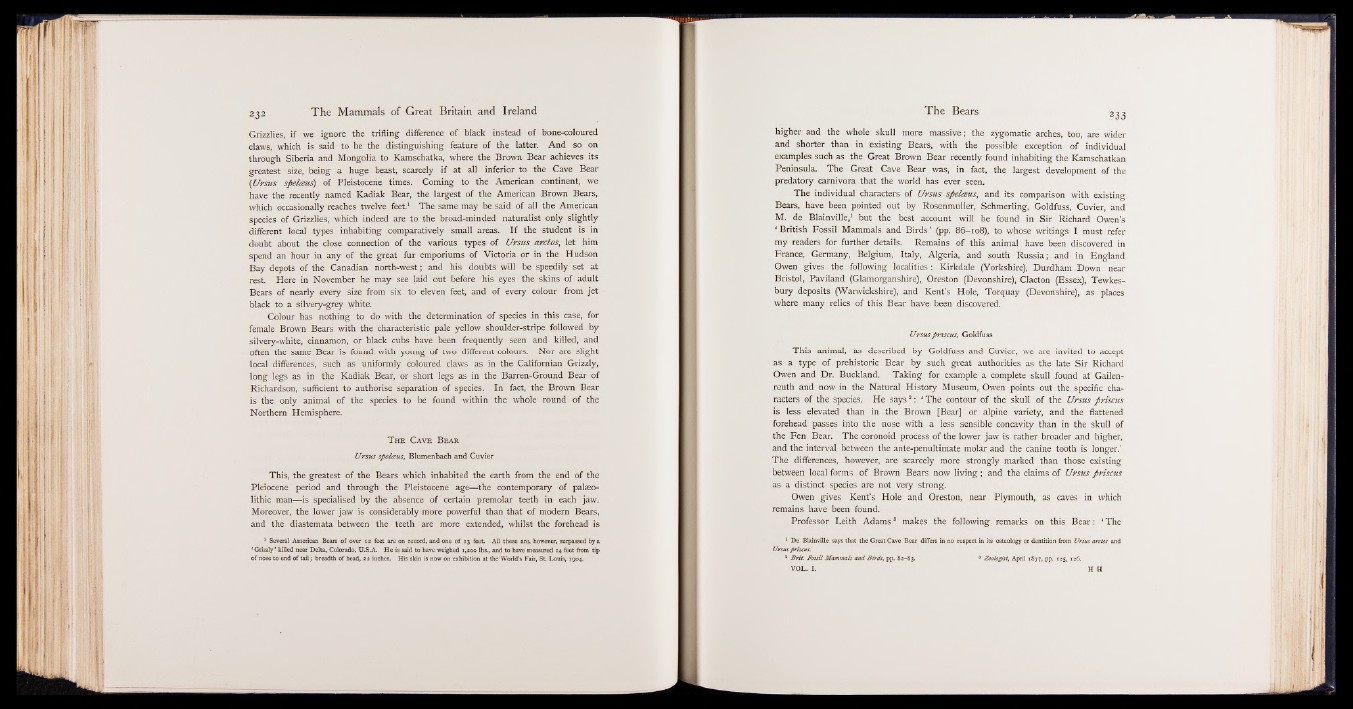
Grizzlies, if we ignore the trifling difference of black instead of bone-coloured
claws, which is said to be the distinguishing feature of the latter. And so on
through Siberia and Mongolia to Kamschatka, where the Brown Bear achieves its
greatest size, being a huge beast, scarcely if at all inferior to the Cave Bear
{Ursus spelceus) of Pleistocene times. Coming to the American continent, we
have the recently named Kadiak Bear, the largest of the American Brown Bears,
which occasionally reaches twelve feet.1 The same may be said of all the American
species of Grizzlies, which indeed are to the broad-minded naturalist only slightly
different local types inhabiting comparatively small areas. I f the student is in
doubt about the close connection of the various types of Ursus arctos, let him
spend an hour in any of the great fur emporiums of Victoria or in the Hudson
Bay depots of the Canadian north-west; and his doubts will be speedily set at
rest. Here in November he may see laid out before his eyes the skins of adult
Bears of nearly every size from six to eleven feet, and of every colour from jet
black to a silvery-grey white.
Colour has nothing to do with the determination of species in this case, for
female Brown Bears with the characteristic pale yellow shoulder-stripe followed by
silvery-white, cinnamon, or black cubs have been frequently seen and killed, and
often the same Bear is found with young of two different colours. Nor are slight
local differences, such as uniformly coloured claws as in the Californian Grizzly,
long legs as in the Kadiak Bear, or short legs as in the Barren-Ground Bear of
Richardson, sufficient to authorise separation of species. In fact, the Brown Bear
is the only animal of the species to be found within the whole round of the
Northern Hemisphere.
T h e C a v e B e a r
Ursus spelceus, Blumenbach and Cuvier
This, the greatest of the Bears which inhabited the earth from the end of the
Pleiocene period and through the Pleistocene age— the contemporary of palaeolithic
man— is specialised by the absence of certain premolar teeth in each jaw.
Moreover, the lower jaw is considerably more powerful than that of modern Bears,
and the diastemata between the teeth are more extended, whilst the forehead is
1 Several American Bears of over 12 feet are on record, and one of 13 feet. All these are, however, surpassed by a
' Grizzly ’ killed near Delta, Colorado, U.S.A He is said to have weighed 1,200 lbs., and to have measured 14 feet from tip
of nose to end of tail; breadth of head, 22 inches. His skin is now on exhibition at the World’s Fair, S t Louis, 1904.
higher and the whole skull more massive; the zygomatic arches, too, are wider
and shorter than in existing Bears, with the possible exception of individual
examples such as the Great Brown Bear recently found inhabiting the Kamschatkan
Peninsula. The Great Cave Bear was, in fact, the largest development of the
predatory carnivora that the world has ever seen.
The individual characters of Ursus spelceus, and its comparison with existing
Bears, have been pointed out by Rosenmuller, Schmerling, Goldfuslf Cuvier, and
M. de Blainville;! , but the best account !p l| t be found in Sir Richard Owen’s
’ British Fossil Mammals and Birdfef’' (pp. 86-108), to whp!s® writings I must refer
my readers for further details. Remains of this animal have been discovered in
France, Germany, Belgium, Italy, Algeria, and south Russia; and in England
Owen gives the following localities Kirkdale (Yorkshire), Durdham Down near
Bristol, Paviland (Glamorganshire), Oreston (Devonshire), Clacton (Essex), Tewkesbury
deposits (Warwickshire), and Kent’s Hole, Torquay (Devonshire), as places
where many relics of this Bear have been discovered.
Ursus pnscus, Goldfuss
This animal, as described by Goldfuss and Cuvier, we are invited to accept
as a type of prehistoric Bear by such great authorities as the late Sir Richard
Owen and Dr. Buckland. Taking for example a complete skull found at Gailen-
reuth and now in the Natural History Museum, Owen points out the specific characters
of the species. He says2: ‘ The contour of the skull of the Ursus priscus
is less elevated than in the Brown [Bear] or alpine variety, and the flattened
forehead passes into the nose with a less sensible concavity than in the skull of
the Fen Bear. The coronoid process of the lower jaw is rather broader and higher,
and the interval between the ante-penultimate molar and the canine tooth is longer.’
The differences, however, are scarcely more strongly marked than those existing
between local forms of Brown Bears now living; and the claims of Ursus priscus
as a distinct species are not very strong.
Owen gives Kent’s Hole and Oreston, near Plymouth, as caves in which
remains have been found.
Professor Leith Adams8 makes the following remarks on this Bear: ‘ The
1 De Blainville says that the Great Cave Bear differs in no respect in its osteology or dentition from Ursus arctos and
Ursus priscus.
* Brit. Fossil Mammals and Birds, pp. 82-83. 8 Zoologist, April 1877, pp. 125, 126.
VOL. I. H H